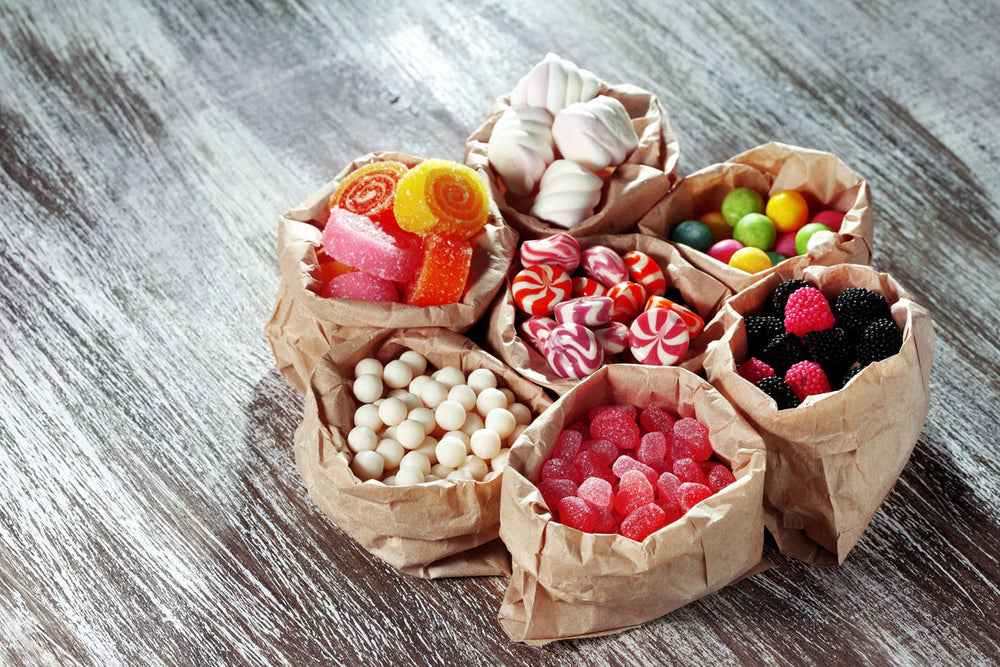Candies have been around for centuries. Over time, they have changed form, shapes, flavours and textures but they have always delighted our palates. While the origin of candies cannot be traced to an exact year but the earliest candies came in the form of honey, fruits and nuts. In Europe, they were a luxurious treat in the Middle Ages and were often reserved for the rich. However, candy today is something that is available to everyone as they are not very expensive. Let us learn more about candies that are made in Europe and America:
1. Ingredients and Sweetness
The choice of ingredients shapes the foundation of candy in both Europe and America.
European Candies
European candies are made from high-quality and natural ingredients such as real fruit extracts, premium cocoa and natural sweeteners. This gives the candies a more balanced sweetness and helps to highlight the actual flavours of the ingredients present in the candy.
American Candies
American candies often use artificial flavours and high-fructose corn syrup to make the candies sweet. While the intention is to make them taste different and unique, they are very sugary.
2. Flavours Used in Candies
The flavour preferences reflect the cultural palate of each region.
European Candies
The Europeans are used to subtle and refined flavours such as hazelnut, marzipan, dark chocolate and liquorice. They are also more natural flavours and are quite sophisticated too.
American Candies
Americans generally like to discover bold and creative flavours and look forward to trying flavours like butter, s’mores and sour combinations. Some examples include Reese’s Peanut Butter Cups and Sour Patch Kids.
3. Texture Preferences in Candies
Texture enhances the candy experience.
European Candies
European candies often feature smooth and delicate textures, such as creamy pralines and chewy nougats, this is seen in treats like Ferrero Rocher and Lindt truffles. The European candies have textures that are obtained from the natural ingredients present in them.
American Candies
American candies focus on lively textures such as crunchy M&M’s or gooey Tootsie Rolls which reveal fun and excitement with every bite.
4. Chocolates

Chocolate is a key area of difference in candy production.
European Candies
European chocolates are known for their creamy texture and rich taste, made with high cocoa content and minimal additives. Strict regulations ensure the use of natural ingredients, resulting in a luxurious and indulgent experience.
American Candies
American chocolates are sweeter and often include stabilizers like paraffin wax for extended shelf life. Hershey’s is a classic example with its distinct taste profile.
5. Candy Bars
Candy bars showcase the different approaches to indulgence.
European Candies
European candy bars emphasize balance and sophistication, blending natural ingredients with high-quality chocolate. They are crafted to provide a harmonious flavour experience, reflecting an artisanal approach.
American Candies
American candy bars focus on bold, sweet flavours and creative combinations. However, the emphasis on heavy sweetness often overshadows the balance and refinement seen in European candy bars.
European candies stand out for their emphasis on quality, craftsmanship, and balanced flavours. They are made with premium ingredients like high cocoa content in chocolates and natural sweeteners, resulting in a refined taste that appeals to a sophisticated palate. With stricter production standards and a focus on tradition, European candies offer a luxurious experience, prioritizing authenticity and sustainability. While American candies are fun and creative, European sweets excel in delivering a more elegant and artisanal indulgence.


 Christmas 2025
Christmas 2025
 Frozen Food
Frozen Food
 Baking
Baking
 Beans, Peas, Soups & Tins
Beans, Peas, Soups & Tins
 Biscuits, Crackers & Cookies
Biscuits, Crackers & Cookies
 Candy / Sweets
Candy / Sweets
 Crisps & Snacks
Crisps & Snacks
 Chemist / Pharmacy
Chemist / Pharmacy
 Desserts
Desserts
 Gravy, Stock & Paste
Gravy, Stock & Paste
 Haggis
Haggis
 Indian Sauces, Paste and Pickle
Indian Sauces, Paste and Pickle
 Jams & Preserves
Jams & Preserves
 Poppy Appeal
Poppy Appeal
 Pot Noodles & Super Noodles
Pot Noodles & Super Noodles
 Scone Mix
Scone Mix
 Gluten-Free / Free From
Gluten-Free / Free From
 Tea Accessories
Tea Accessories
 Teapot & Tea sets
Teapot & Tea sets
 Tea For One
Tea For One
 Sugar & Creamer
Sugar & Creamer
 Tableware
Tableware
 Serveware
Serveware
 Plates & Trays
Plates & Trays
 Bowls
Bowls
 Cups & Saucers
Cups & Saucers
 Mugs
Mugs
 Silverware
Silverware
 Dinnerware - Accessories
Dinnerware - Accessories
 Dinnerware - For Pets
Dinnerware - For Pets
 Victoria Eggs - Hand-Drawn UK Homeware
Victoria Eggs - Hand-Drawn UK Homeware
 Jewelry & Accessories
Jewelry & Accessories
 Sale
Sale
 Christmas Gifts
Christmas Gifts

